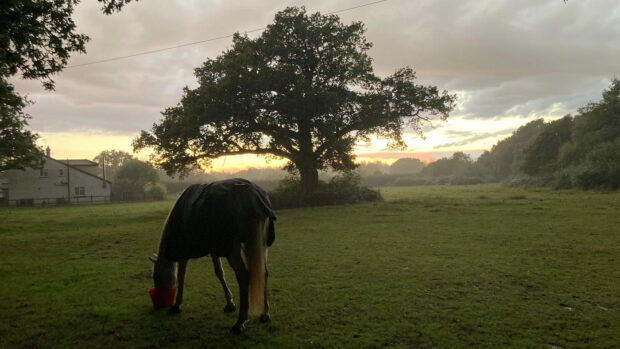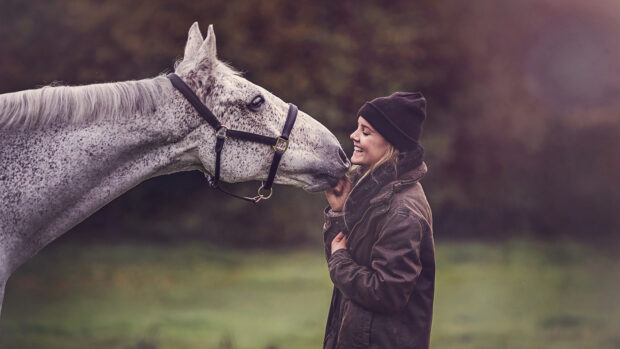Winter is expensive for horse owners, but feeding the right diet pays dividends, so we’ve asked the experts how to save money on feeding your horse without skimping on their essential needs.
“The aim of winter feeding is to ensure horses maintain good condition and stay healthy,” says Baileys Horse Feeds’ senior nutritionist Emma Short. “Due to poor weather conditions, horses require a good balance of nutrients and energy to support them, particularly as the grass quality declines.”
Deborah Leabeater, senior nutritionist for HorseHage, adds: “The importance of selecting good quality forage for winter feeding cannot be overemphasised – to support both respiratory and gut health, as well as meeting the psychological need to chew during long periods in the stable.”
But each breed, height and type of horse has very different needs. Here, we take a look at four popular types of horse to find out what they typically require in terms of hard feed and forage, and what changes you could make to save money on feeding your horse this winter.
Feeding the poor-doer or veteran
“It is advisable to change your feeding regime gradually in the autumn to prevent weight loss in winter,” says Emma. “A horse weighing 500kg requires about 12.5kg of feed per day for weight gain. This could comprise of 3kg of a conditioning cube, ad-lib forage or 9.5kg of hay (12.5kg of haylage).”
“Forage should be offered on an ad-lib basis, ensuring that at least 1.5–2% of bodyweight is being eaten as fibre,” advises registered nutritionist Lizzie Drury of Saracen Horse Feeds.
“Some older horses may struggle to eat the quantity of forage required to maintain condition, so including highly palatable, good quality haylage as part of the forage allocation will promote appetite and intake” adds Deborah.
In addition, the poor-doer will require a nutrient-dense bucket feed. “We recommend a conditioning feed balancer topped up with a low sugar/starch conditioning blend,” advises TopSpec nutrition director Nicola Tyler.
“Older horses often have poor dentition,” explains Dengie’s Katie Williams. “An easy-to-chew, high-fibre diet in the form of soft grasses and alfalfa will help.”
Soaked fibre feeds can be fed alongside or instead of a chopped fibre feed – “they are also ideal for aiding hydration”, says Katie.
Blue Chip nutrition adviser Anna Franklin advises feeding probiotics to help your horse absorb the full nutritional profile of their diet.
“Poor-doers will also benefit from additional calories such as soya or linseed oil, but make sure you also feed antioxidants to combat the oxidative effect of feeding oil.”
The veteran: a 21-year-old Hanoverian
Workload: schooled and hacked three or four times a week. Turned out daily.
Suggested feed: one scoop Dengie Healthy Tummy chaff, one scoop Saracen Show Improver nuts, one cup Saracen Equi-Jewel twice a day, and ad-lib forage, including Timothy HorseHage.
Feeding the competition horse
Competition horses may spend more time in their stables during the winter months and Deborah says: “It’s important to remember that the respiratory challenge from dust and spores in the stable environment is increased in the winter months. Good quality forage should be low in dust and spores, but for horses who have respiratory issues, feeding good quality haylage will significantly reduce the challenge, to help ensure the horse’s lungs stays healthy for optimum competition performance”.
“Ask whether the horse needs stamina or power, or even if it needs a competition feed at all,” says Lizzie Drury. “Many competition horses will do perfectly well on a feed balancer.”
Optimum fibre intake in competition horses is paramount to reduce gastric ulcers. “Minimum intakes should be at least 1.5% of bodyweight,” adds Lizzie. “For 500kg horses, minimum hard feed intakes may be between 3–4kg per day, although some will need as little as 2.5kg per day.”
“Concentrate feed is also a means of supplying key amino acids, vitamins, and minerals to complement forage,” says Emma Short. “This will help develop muscle tone.”
“A source of quick-release energy such as oats can be added alongside a high-calorie fibre and high-specification balancer, to create extra sparkle if needed,” says Katie Williams.
The competition horse:a 12-year-old thoroughbred
Workload: mainly does dressage, up to British Dressage medium, and 90cm showjumping and eventing as well. Ridden five days a week and competing a minimum of once a week. Turned out daily.
Feed: one scoop of Baileys No4 conditioning cubes, a good handful of Mollichaff Herbal and a scoop of Fibre-Beet twice a day, plus ad-lib forage including High Fibre HorseHage.
Feeding the busy hunter
“Be prepared to feed three hard feeds a day during the second half of the season because hunting is hard work,” says Nicola Tyler.
“Many need conditioning feeds and fat supplements to help fuel the stamina to hunt all day, while also needing a higher level of energy and calories to maintain their body condition,” says Lizzie Drury. “They should be eating plenty of long-stem fibre, aimed at 2–2.5% of bodyweight. If fibre intakes are low, look for alternatives such as high-fibre cubes or short-chop forages. Hard feed intakes are likely to be around up to 4–5kg per day.”
Deborah adds: “During the season, many hunters have little or no turnout, and the higher retained levels of B vitamins in good quality haylage compared with hay can be important to support energy production and appetite in hard working horses – as well as providing respiratory benefits.”
Adding a good-quality balancer alongside ensures the horse is getting all the vitamins and minerals they need.
“Feed a balancer that contains a high specification of vitamins and minerals as well as glucosamine for joint support, B vitamins for energy breakdown and utilisation, prebiotics for gut health and improved feed utilisation, and biotin for hoof health,” Katie Williams advises. “Adding a soaked fibre feed aids hydration and salt can also be added to replace electrolytes lost through sweating.”
“Look for a diet high in quality digestible protein and ingredients such as nucleotides which help cell repair and regeneration,” says Anna Franklin. “Oil can be fed for additional calories as balancers contain antioxidants.”
The hunter: a 12-year-old Irish Sport Horse
Workload: hunts once a week, and schools and hacks three or four times a week.
Feed: one scoop of Blue Chip Original Feed Balancer, one scoop of Coolstance Copra and a handful of Mollichaff Showshine once a day, together with ad-lib forage, including high energy Ryegrass HorseHage. On a hunting day she has two feeds and ad-lib forage, including high energy Ryegrass HorseHage.
Feeding a good-doer
“Winter can be a useful time to get excess weight off good-doers, so don’t be tempted to overfeed them,” says Emma Short. “However, feeding less of a mix or cube may keep the calories low, but it could also deprive your horse of essential nutrients.”
The best way to feed a good-doer is to feed a low-calorie feed balancer alongside forage. If the balanced is fed at the recommended levels, there should be no need to feed supplements, unless the horse has specific requirements for nutritional support, such as in the form of a calmer. Cutting out supplements can be one way of save money on feeding your horse.
“A pony weighing 300kg, in light work, would need 300g of a balancer alongside a minimum of 4.5–5.5kg of hay,” adds Emma. “Hay is preferable to haylage.”
“The good-doer should ideally be fed ad-lib late-cut hay unless he is overweight, when meadow hay soaked is more suitable than restricting hay intake,” advises Nicola Tyler.
Katie Williams, has advice for those horses whose grazing and hay intake does need limiting.
“Grazing can be restricted by strip-grazing or wearing a grazing muzzle and hay can be soaked to reduce the calorie and sugar levels. Using small-holed haynets or double netting can also help your horse’s hay ration last longer,” she says.
Anna Franklin adds: “Get into a good habit of weighing your horse’s forage daily. Use the winter to kick-start a weight-loss programme, too.”
The Pony Club pony: a 12-year-old part-Dartmoor
Workload: hacked and schooled three times a week alongside hunting or Pony Club events at weekends. Turned out daily.
Feed: three-quarters of a scoop of Allen & Page Fast Fibre, a good handful of Dengie Alfa A Oil and half a mug of Castle Horse Feeds Smart Linseed once a day. A couple of nights before a competition she has half a scoop of Dodson & Horrell Competition Mix. She is also fed ad-lib hay.
How to save money on feeding your horse
- Make sure you aren’t doubling up on nutrients
- Use a chopped fibre as your bucket feed
- Balancers can be more cost-effective than a mix or cube
- Introduce weight-gaining diets in good time
- Monitor your horse’s body condition regularly so you can act quickly when needed
- Weigh your feed and hay
- Source the best possible hay or haylage
- Feed forage in a net or feeder to avoid wastage
- Cheaper feeds can be a false economy as they often have fewer quality ingredients
- Don’t overdo it – big feeds are harder to digest
- Placing your feed balancer in a treat ball can extend feeding time for stabled horses
- Salt licks are a good option, but also include salt and/or electrolytes where needed as horses can’t be relied on to self regulate effectively
- Keeping the horse warm and dry is effective when trying to save money on feed
- Similarly, regular worm egg counts, and regular visits from a qualified equine dental technician or vet should all form part of your seasonal, cost-saving routine
You may also be interested in…

Trying to save money on your horse bills? Take a look at these top tips

Feed balancers: what’s on the market?

Know your forage: which is the perfect type for your horse?

Subscribe to Horse & Hound magazine today – and enjoy unlimited website access all year round
Horse & Hound magazine, out every Thursday, is packed with all the latest news and reports, as well as interviews, specials, nostalgia, vet and training advice. Find how you can enjoy the magazine delivered to your door every week, plus options to upgrade your subscription to access our online service that brings you breaking news and reports as well as other benefits.





